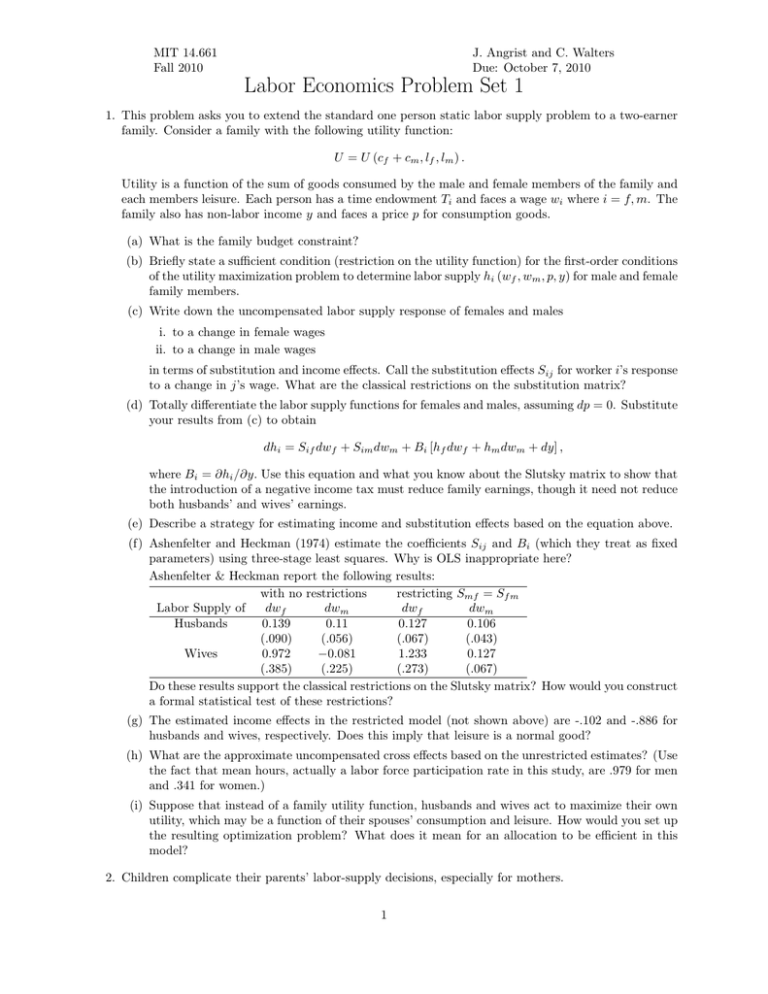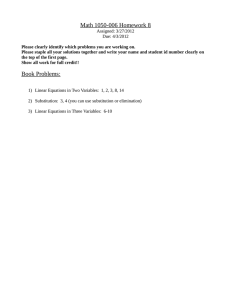Labor Economics Problem Set 1
advertisement

MIT 14.661 Fall 2010 J. Angrist and C. Walters Due: October 7, 2010 Labor Economics Problem Set 1 1. This problem asks you to extend the standard one person static labor supply problem to a two-earner family. Consider a family with the following utility function: U = U (cf + cm , lf , lm ) . Utility is a function of the sum of goods consumed by the male and female members of the family and each members leisure. Each person has a time endowment Ti and faces a wage wi where i = f, m. The family also has non-labor income y and faces a price p for consumption goods. (a) What is the family budget constraint? (b) Briefly state a sufficient condition (restriction on the utility function) for the first-order conditions of the utility maximization problem to determine labor supply hi (wf , wm , p, y) for male and female family members. (c) Write down the uncompensated labor supply response of females and males i. to a change in female wages ii. to a change in male wages in terms of substitution and income effects. Call the substitution effects Sij for worker i’s response to a change in j’s wage. What are the classical restrictions on the substitution matrix? (d) Totally differentiate the labor supply functions for females and males, assuming dp = 0. Substitute your results from (c) to obtain dhi = Sif dwf + Sim dwm + Bi [hf dwf + hm dwm + dy] , where Bi = ∂hi /∂y. Use this equation and what you know about the Slutsky matrix to show that the introduction of a negative income tax must reduce family earnings, though it need not reduce both husbands’ and wives’ earnings. (e) Describe a strategy for estimating income and substitution effects based on the equation above. (f) Ashenfelter and Heckman (1974) estimate the coefficients Sij and Bi (which they treat as fixed parameters) using three-stage least squares. Why is OLS inappropriate here? Ashenfelter & Heckman report the following results: with no restrictions restricting Smf = Sf m Labor Supply of dwf dwm dwf dwm Husbands 0.139 0.11 0.127 0.106 (.090) (.056) (.067) (.043) Wives 0.972 −0.081 1.233 0.127 (.385) (.225) (.273) (.067) Do these results support the classical restrictions on the Slutsky matrix? How would you construct a formal statistical test of these restrictions? (g) The estimated income effects in the restricted model (not shown above) are -.102 and -.886 for husbands and wives, respectively. Does this imply that leisure is a normal good? (h) What are the approximate uncompensated cross effects based on the unrestricted estimates? (Use the fact that mean hours, actually a labor force participation rate in this study, are .979 for men and .341 for women.) (i) Suppose that instead of a family utility function, husbands and wives act to maximize their own utility, which may be a function of their spouses’ consumption and leisure. How would you set up the resulting optimization problem? What does it mean for an allocation to be efficient in this model? 2. Children complicate their parents’ labor-supply decisions, especially for mothers. 1 (a) Use a graph to show how women’s labor supply decisions are affected by child care costs, assuming she is the only adult in the household. (b) Describe the impact of a lump-sum child allowance that is phased out as income or earnings rise. Compare this with the effect of publicly-provided child care for all, as is often found in Europe. (c) Discuss the ways in which state-provided out-of-home care might affect children. What does the evidence suggest? 3. Life-cycle labor supply (a) Derive the λ-constant labor supply and commodity demand functions for the Heckman and MaCurdy (1980) utility function. To simplify notation, use time subscripts instead of paren­ theses. You can also assume the interest rate is fixed. i. What is the intertemporal substitution elasticity for this model? Why is this parameter necessarily (i.e., theoretically) positive? How do wages affect consumption? Why? ii. What does this model predict about the behavioral response to the following sources of variation in wages: Cross-sectional variation associated with permanent differences in human capital; Wage increases generated by changes in labor market experience; Transitory shocks caused by changes in the macro economy; Changes in after-tax wages caused by a temporary NIT program; Job loss at age 50. (b) Construct a PSID extract similar to the one used by Angrist (1991). PSID data are available from the ICPSR: http://www.icpsr.umich.edu/cocoon/ICPSR/STUDY/07439.xml (use the Wave I cross-year individual file). i. Calculate the grouped-data, Analysis of Covariance (fixed-effects), and OLS estimates of MaCurdry’s (1981) specification reported by Angrist (1991, Table 3). You should be able to come close to these estimates after replicating the sample selection criteria and estimation procedures as best you can. ii. What is the Angrist (1991) interpretation of the differences in results across methods? iii. Why does Card (1994) take a skeptical view of the large positive intertemporal substitution elasticities that are generated by the grouped-data estimator in PSID data? Do bicycle messengers and cab drivers answer Card’s concerns? 2 MIT OpenCourseWare http://ocw.mit.edu 14.661 Labor Economics I Fall 2010 For information about citing these materials or our Terms of Use, visit: http://ocw.mit.edu/terms.




